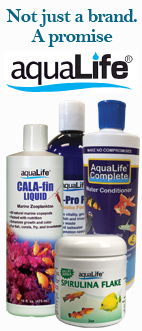|
|
Product Detail
|
|
|
 |
| Item#: |
SC3116 |
|
|
|

|
|
|
|
| Product Name: |
Purigen 250ml
|
|
| Category: |
Filter & Reactor Media* |
|
| Subcategory: |
Organics Control |
|
| Manufacturer: |
Seachem |
|
|
|
|
Purigen is a premium synthetic adsorbent that is unlike any other filtration product. It is not a mixture of ion exchangers or adsorbents, but a unique macro-porous synthetic polymer that removes soluble and insoluble impurities from water at a rate and capacity that exceeds all others by over 500%. Purigen controls ammonia, nitrites, and nitrates by removing nitrogenous organic waste that would otherwise release these harmful compounds. Purigen's impact on trace elements is minimal. It significantly raises redox. It polishes water to unparalleled clarity. Purigen darkens progressively as it exhausts and is easily renewed by treating with bleach. Purigen is designed for both marine and freshwater use. This product is sold by volume. Cited weight is minimal weight.
DIRECTIONS: Rinse before use. Use in a fine mesh filter bag. Each 1 L treats up to 4,000 L (1,000 gallons*) for up to six months. Exhaustion is indicated by a pronounced discoloration of the beads to dark brown or black.
Regeneration: Soak in a 1:1 bleach and water solution for 24 hours in a non-metalic container in a well ventilated area and away from children. Rinse well, then soak for 8 hours with a solution containing 2 tablespoons of ChlorGuard, Prime, or equivalent dechlorinator per cup of water. Rinse well. For freshwater use, soak for 4 hours with a solution containing 1 tablespoon of buffer per cup of water (Discus Buffer, Neutral Regulator, or Acid Buffer). Original color and full activity should now be restored and Purigen is ready for reuse. Caution: some slime coat products may permanently foul Purigen and render regeneration difficult. Do not reuse if odor of chlorine is detectable. In case of doubt, soak beads in small quantity of water and test for residual chlorine with a chlorine test kit.
Q: When is Purigen exhausted and how do I regenerate it?
A: Purigen will turn from its normal color to a deep brown when it is exhausted. Purigen can easily be regenerated by soaking it in a solution of hyperchlorite (generic) bleach overnight. The Purigen will return to its original color. Then rinse well and dechlorinate using Prime or Safe to remove any chlorine. For freshwater, use a buffer to adjust the pH as needed due to bleach's high pH.
Q: Will Purigen reduce GH (general hardness or calcium/magnesium ion levels)? Is it meant to be a substitute for activated carbon or should it be used with carbon?
A: No, Purigen will not impact calcium/magnesium hardness. It is superior to carbon in removing organics and not having negative impacts, but it is also compatible with carbon. The use of carbon with Purigen will extend the useful life of Purigen.
Q: On some of the Purigen documentation I have read it says that some slime coat products can contaminate Purigen and render it toxic. Can you identify these products?
A: Only certain slime coat products will cause Purigen to become toxic; the products that do this are amine based. Prime and Safe are not amine based and so will not cause this problem. If you're curious, what happens is that the amine compounds can strongly bind to the resin, then when they (the amines) come into contact with any chlorine they will form chloramines which are highly toxic. We offer a stress coat product, StressGuard, which is not amine based and so can be used in conjunction with Purigen.
Q: I recently just regenerated the Purigen product. In the end, I used your neutral buffering product for the final process rather than the Discus or acid bufferer like suggested. It was under my rational that the reason we use the buffer was that the regeneratory process basically renders the product as at one extreme end of the PH scale. We are basically just preventing it from affecting our overall pH by buffering it. Since I strive to keep my aquarium at a pH of 7.0 was this a correct action on my behalf?
A: This was a correct assumption and I do not see a problem with your action. As a precaution, I would test it in a cup of water (preferably RO or DI). If putting the fully regenerated product in DI water results in the pH of the DI water rising above 8.0, I would reintroduce the resin to a solution of Neutral Regulator for a few hours. |
|
|
|
|
|





